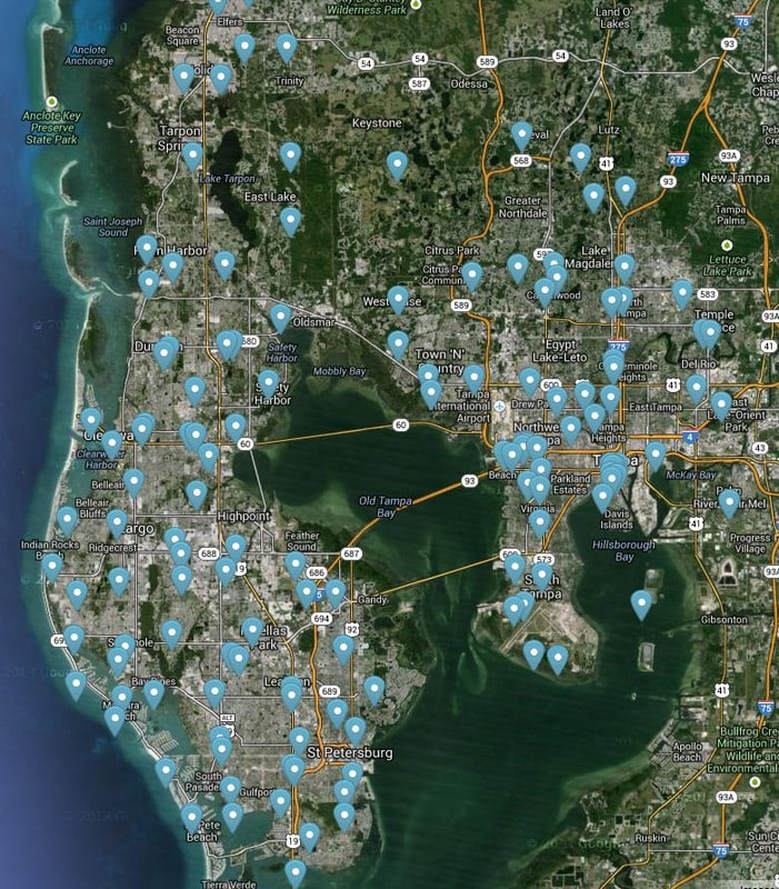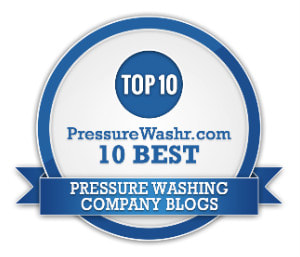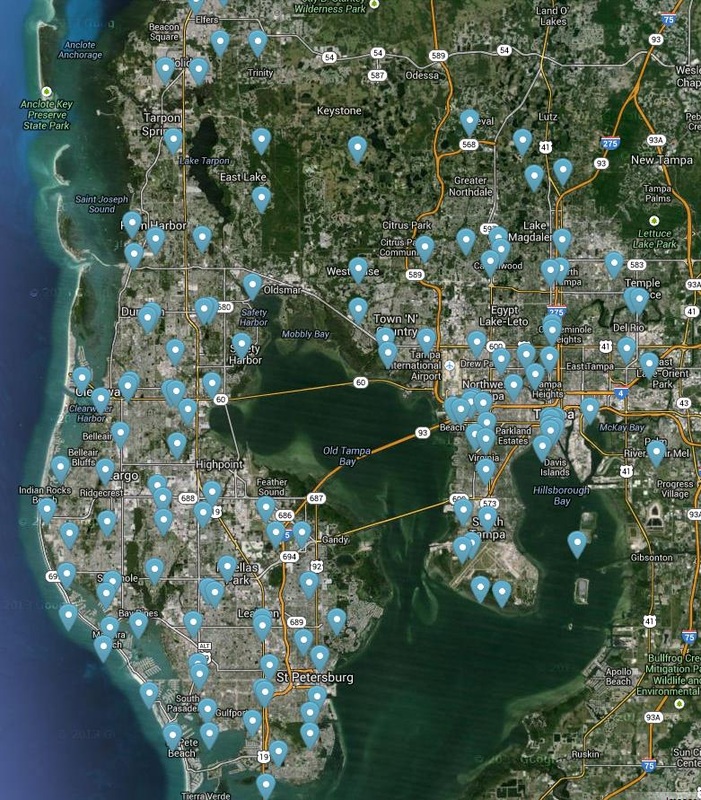HOW-TO Articles on Pressure Washing In Clearwater And Tampa Bay
On this page we are going to supply you with interesting and useful information about your "outdoor" cleaning needs. Watch this space for weekly new articles around the subjects of pressure- or power washing your roof, deck, patio, pool, screen, siding, outdoor furniture, walkways and sidewalk. Whenever possible, we have also linked the articles to How To Videos for more detailed information. Since regular maintenance creates beautiful spaces and long-lasting benefits, we encourage you browse through this page to find answers and to get inspired. Enjoy!
Watch our Pressure Washing How-To Videos
Read our Pressure Washing White Papers
Watch our Pressure Washing How-To Videos
Read our Pressure Washing White Papers
Problems with Black and Green Mold
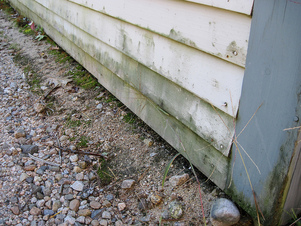
I am sure that you have noticed this for yourself, that the north side of homes is notably more prone to mold-growth then any of the other detached walls of a home. It's the simple fact, that the surfaces facing north receive less sunlight and such dark and damp places promote the growth of mold.
Mold is a fungus that grows well inside as it does outside of homes. This fungus comes in different colors, from an off-white to black, we have seen them all. It thrives in damp, dark and humid locations and can grow on many different kinds of surfaces. Molds can be found almost anywhere; they can grow on virtually any substance, providing moisture is present. There are molds that can grow on stone, wood, paper, carpet and foods.
Outdoor mold, if not removed promptly, can stain, discolor and damage your siding, walls, roof, deck, tiles and concrete floors as well as any other structure. If the mold is not removed, it will eat away at the surface and over time, this will deteriorate the item. When you find mold is growing on the outside of your home, remove it as soon as possible.
Since we live in Florida, all of our outside spaces are exposed to excessive moisture and humidity, which is a major contributing factor to mold growth. Mold and mildew spores generally appear as powdery stains on home exteriors. They become more attached to sidings over time, when the deterioration process starts. It is recommended to clean mold off the exterior walls of a house promptly, to improve the house's longevity and general appearance.
Molds produce tiny spores to reproduce, just like some plants that produce seeds. These mold spores can be found indoors and outdoors, flying through the air and settling on indoor and outdoor surfaces. When these mold spores touch down on a damp spot, they can begin growing and digesting whatever they are growing on in order to survive. Since molds gradually destroy the things they grow on, you should prevent damage to building materials and save money by eliminating mold growth.
The good news is: Regularly cleaning home exteriors will inhibit mold growth! Our team at DPI Pressure Washing Clearwater, is here in the Tampa Bay area to help you get this problem under control.
Mold is a fungus that grows well inside as it does outside of homes. This fungus comes in different colors, from an off-white to black, we have seen them all. It thrives in damp, dark and humid locations and can grow on many different kinds of surfaces. Molds can be found almost anywhere; they can grow on virtually any substance, providing moisture is present. There are molds that can grow on stone, wood, paper, carpet and foods.
Outdoor mold, if not removed promptly, can stain, discolor and damage your siding, walls, roof, deck, tiles and concrete floors as well as any other structure. If the mold is not removed, it will eat away at the surface and over time, this will deteriorate the item. When you find mold is growing on the outside of your home, remove it as soon as possible.
Since we live in Florida, all of our outside spaces are exposed to excessive moisture and humidity, which is a major contributing factor to mold growth. Mold and mildew spores generally appear as powdery stains on home exteriors. They become more attached to sidings over time, when the deterioration process starts. It is recommended to clean mold off the exterior walls of a house promptly, to improve the house's longevity and general appearance.
Molds produce tiny spores to reproduce, just like some plants that produce seeds. These mold spores can be found indoors and outdoors, flying through the air and settling on indoor and outdoor surfaces. When these mold spores touch down on a damp spot, they can begin growing and digesting whatever they are growing on in order to survive. Since molds gradually destroy the things they grow on, you should prevent damage to building materials and save money by eliminating mold growth.
The good news is: Regularly cleaning home exteriors will inhibit mold growth! Our team at DPI Pressure Washing Clearwater, is here in the Tampa Bay area to help you get this problem under control.
Green-Tips to remove mold from your siding
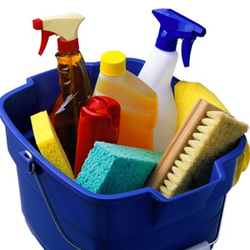
Tip #1
You'll need: White vinegar, a pail, an old cloth and water
Spot-test the vinegar solution on the siding before cleaning the exterior walls to check for discoloration; if the siding becomes discolored, don't use the vinegar solution.
Note: You can substitute the vinegar for a solution of 1 qt. liquid bleach and 1 gallon water. Just know, that lower-quality bleach has impurities which can leave stains that resemble rust on the siding, especially if you do not rinse the siding liberally. So, make sure to get a higher-quality bleach, so this doesn't happen to you.
Tip #2
You'll need: Oxygen Bleach, a bucket, a long-handled spoon, a brush or scrub and water
Tip #3
Tip #4
Tip #5
Oxygen bleach is a safe alternative to chlorine bleach. However, you can use chlorine bleach in place of the oxygen bleach.
Using diluted bleach to kill mold on exterior surfaces:
Tip #6
You'll need: Bleach, liquid dish soap, water, a bucket and a wooden spoon.
Wear rubber gloves when working with chemicals to prevent skin irritation. Never mix bleach with ammonia or products containing ammonia. The resulting fumes are toxic.
If this all sounds too laborious for you, you can always give us a call and we'll take this burden off your shoulders. The Pressure Washing "SWAT"-team is ready to eliminate any nasty fungus growth! Contact
You'll need: White vinegar, a pail, an old cloth and water
- Cover vegetation below the mildew-stained siding with plastic drop cloths. Vinegar kills exposed vegetation.
- Combine 3 cups of distilled white vinegar and 7 cups of water in a pail.
- Immerse a cloth in the diluted solution. Wipe the diluted vinegar onto the moldy siding, thoroughly soaking the mold spores. Leave the solution on the siding surface for 30 minutes to ensure that all mold spores die.
- Scrub the dead mold spores off the siding completely, using a soft brush. Gradually work up the siding, rinsing the siding with water along the way.
- Rinse the entire section of siding to flush off the remaining vinegar.
Spot-test the vinegar solution on the siding before cleaning the exterior walls to check for discoloration; if the siding becomes discolored, don't use the vinegar solution.
Note: You can substitute the vinegar for a solution of 1 qt. liquid bleach and 1 gallon water. Just know, that lower-quality bleach has impurities which can leave stains that resemble rust on the siding, especially if you do not rinse the siding liberally. So, make sure to get a higher-quality bleach, so this doesn't happen to you.
Tip #2
You'll need: Oxygen Bleach, a bucket, a long-handled spoon, a brush or scrub and water
- Pour 2 gallons of warm water into a bucket. Add 2 cups oxygen bleach and mix with a long-handled spoon until the bleach has dissolved.
- Secure an extension handle to the end of a scrub brush. Dip the scrub brush into the mixture. Scrub wood, siding, concrete and painted surfaces with the mixture.
- Let the mixture sit on the surface for 10 to 15 minutes. Rinse the surface clean with a water hose after the allotted time has passed. Repeat the process until you have removed all traces of the mold.
Tip #3
- Clean away dead and decaying vegetation -- such as leaves and twigs -- from around the home's foundation regularly. The dead vegetation provides food for mold.
Tip #4
- Apply a layer of wood sealer to patios, railings and decks to prevent future mold growth. Furthermore, repainting exterior painted surfaces with mildew-resistant paint will help keep fungus from ruining it.
Tip #5
- Prevent mold from growing on your roof by keeping branches trimmed back so they do not hang over the roof. The branches block sunlight from flooding the roof, providing the ideal growing environment for mold and mildew.
Oxygen bleach is a safe alternative to chlorine bleach. However, you can use chlorine bleach in place of the oxygen bleach.
Using diluted bleach to kill mold on exterior surfaces:
Tip #6
You'll need: Bleach, liquid dish soap, water, a bucket and a wooden spoon.
- Remove leaves, dead plants and other debris from around the foundation of your home. These items are potential food for mold. Place the decaying vegetation in a trash bag or compost pile.
- Fill a 5-gallon bucket with 3 qts. of water. Mix 1 qt. of bleach and 1/3 cup of liquid dish soap into the water with a wooden spoon.
- Saturate a scrub brush in the mixture. Scrub the exterior of your home, including concrete, wood, siding and painted surfaces, with the brush.
- Allow the mixture to sit on the surface for 15 minutes. Rinse the mixture off with a water hose.
- Repeat the process until all outdoor mold is removed from your home.
- Gain access to your roof. Spray debris from the roof with a water hose. Scrub the roof with a brush broom saturated in 1 part bleach and 9 parts water. Allow the mixture to sit for 15 minutes, then rinse the roof clean with the water hose.
Wear rubber gloves when working with chemicals to prevent skin irritation. Never mix bleach with ammonia or products containing ammonia. The resulting fumes are toxic.
If this all sounds too laborious for you, you can always give us a call and we'll take this burden off your shoulders. The Pressure Washing "SWAT"-team is ready to eliminate any nasty fungus growth! Contact
Health issues and allergies related to mold exposure
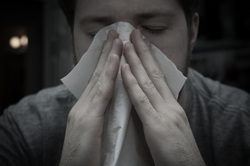
All molds can potentially cause bad health effects as they produce irritants, allergens and in some cases toxins, that may cause reactions in humans. The extent of an individuals exposure and the types of mold present as well as the age of the individual and their sensitivities or allergies will determine the severity of symptoms.
Some mold spores are airborne and will easily get disturbed on contact and settle wherever the wind blows. Others have sticky roots and need to be removed with manual force. Healthy individuals are usually not vulnerable to opportunistic infections from airborne mold exposure. However, molds can cause common skin diseases, such as athlete's foot, as well as other infections such as yeast infections. More information about health risks can be found here.
Source for this article: http://www.epa.gov/mold/moldresources.html and http://www.ehow.com/how_7799037_remove-exterior-mold.html
Some mold spores are airborne and will easily get disturbed on contact and settle wherever the wind blows. Others have sticky roots and need to be removed with manual force. Healthy individuals are usually not vulnerable to opportunistic infections from airborne mold exposure. However, molds can cause common skin diseases, such as athlete's foot, as well as other infections such as yeast infections. More information about health risks can be found here.
Source for this article: http://www.epa.gov/mold/moldresources.html and http://www.ehow.com/how_7799037_remove-exterior-mold.html
Pressure Washing your Pool Area and Screen Enclosure
Are you not using your pool and outdoor spaces as much as you used to because your:

- Children moved out and it became deserted?
- Have less time to enjoy this part of your house?
- Are lacking the previous enthusiasm for it?
- Haven't used it for so long - it looks grubby and uninviting?
- Had no time or money to maintain it?
- Need to tackle the algae build-up and mildew-growth on your own?
No need to be embarrassed if you have not yet had the chance to do something about it. After all, cleaning the pool area by yourself is not something you do in an afternoon, especially not when you also have a screen enclosure to take care of.
Whatever your choice of cleaning might be - on your hands and knees with a scrub and bucket of water or equipped with a garden hose - it will always be a time-consuming, wet and dirty job.
I have looked around to see which product I could safely recommend when cleaning your outdoor surfaces. We here at Pressure Washing Clearwater are doing our part in keeping the environment unpolluted and less burdened with chemicals. Instead of using regular chlorine bleach I tried out a product called Oxygen Bleach (OxiClean) as an environmentally safe alternative. Many people think 'bleach is bleach', but the bleach found in most homes is chlorine bleach. The active ingredient in chlorine bleach is sodium hypochlorite - quite the aggressive chemical as you know from reading the label of many cleaners.
How well does a non-bleach cleaner work?
Instead of washing your surfaces with harsh chemicals that will do damage to the surface, flower beds and your own health by breathing in the toxic fumes, you can use this other product called Oxygen Bleach. This cleaner is made of hydrogen peroxide and soda ash and though it is quite a powerful cleaner and just about as green as you can get. However, I found it not working well enough for commercial use and to replace bleach. Nowadays we use a highly diluted mixture of regular bleach with water to break apart dirt, algae and mildew molecules. This solution is not toxic for surrounding plants or the worker applying it!
If you embark on doing this task yourself, now it's time to roll up your sleeves, use some elbow grease and mechanical agitation by using a scrub brush on a pole to get your pool area squeaky clean. :-)
Enjoy your Outdoors More with a Freshly Cleaned Deck or Patio
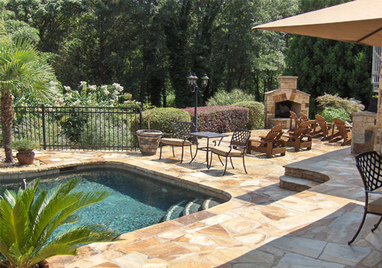
We like it when it's new and forget over time how it looked when it was first installed: Wood and even stones weather as time goes by and that can have it's own charm.
But our Florida climate doesn't help with keeping things looking fresh and new. All too soon we see a thin green (or black) film building up on our garden furniture, patio, deck and other wooden surfaces that comes off quite easily at first but keeps coming back like clockwork. The intruder is an algae and with the help of our humidity and the closeness to the ocean it will keep growing until you come along with a bucket of soapy water and a brush and wash it off.
And even then: Unfortunately, algae and fungus don't go away in our Florida climate, they just become dormant during winter - waiting for spring to blossom again. As the algae and fungus grow on your patio or deck, they prepare the grounds for moss to hold on to. Moss roots can also work their way into wood decks or other wood structures.
As a word of warning: When you notice, that your deck, patio and pool areas are covered with this thin green or black film it usually becomes very slippery when wet. Make sure to clean the surfaces either yourself or let a competent company like mine help you eliminate the problem. Pressure cleaning decks and patios is a recurring necessity. With regular professional pressure washing service you can keep their growth in check, save money and the trouble of having someone slip on your deck and get hurt.
Besides: A clean deck or patio is a much nicer place to invite friends and family to. You will be so pleased to see the natural beauty of your wood, stone, compact or tiles (again) once the cleaning is done that you probably spend more time outside enjoying the space. ;-)
Give me a call at our Clearwater office 1-813-991-7243 to schedule a cleaning or use the contact form on this website to get more information and a FREE Estimate from us. Note that we respect your privacy and will treat your information as private and confidential. Our friendly team is on-time and most cautious with your property.
Need a FREE Quote?
Call 1-813-991-7243
But our Florida climate doesn't help with keeping things looking fresh and new. All too soon we see a thin green (or black) film building up on our garden furniture, patio, deck and other wooden surfaces that comes off quite easily at first but keeps coming back like clockwork. The intruder is an algae and with the help of our humidity and the closeness to the ocean it will keep growing until you come along with a bucket of soapy water and a brush and wash it off.
And even then: Unfortunately, algae and fungus don't go away in our Florida climate, they just become dormant during winter - waiting for spring to blossom again. As the algae and fungus grow on your patio or deck, they prepare the grounds for moss to hold on to. Moss roots can also work their way into wood decks or other wood structures.
As a word of warning: When you notice, that your deck, patio and pool areas are covered with this thin green or black film it usually becomes very slippery when wet. Make sure to clean the surfaces either yourself or let a competent company like mine help you eliminate the problem. Pressure cleaning decks and patios is a recurring necessity. With regular professional pressure washing service you can keep their growth in check, save money and the trouble of having someone slip on your deck and get hurt.
Besides: A clean deck or patio is a much nicer place to invite friends and family to. You will be so pleased to see the natural beauty of your wood, stone, compact or tiles (again) once the cleaning is done that you probably spend more time outside enjoying the space. ;-)
Give me a call at our Clearwater office 1-813-991-7243 to schedule a cleaning or use the contact form on this website to get more information and a FREE Estimate from us. Note that we respect your privacy and will treat your information as private and confidential. Our friendly team is on-time and most cautious with your property.
Need a FREE Quote?
Call 1-813-991-7243
Transform your unsightly deck or patio into an outdoor space, where you can proudly invite your friends!
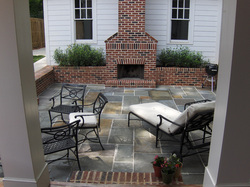
All decks, even low maintenance decks, require regular cleaning to keep looking and performing well. Over time algae, dirt, mold, and mildew will create a film over an outdoor deck that looks ugly and can be slippery. Fallen leaves will start rotting and over time discolor and harm the surface of your deck. Most people give their deck at least one good cleaning every Spring. Our humid Florida weather and the amount of dirt, leaves and build up might make it necessary to clean the deck more frequently. We recommend using a green deck cleaner that uses oxygen bleach as the active ingredient. There are several good products on the market. (We will give you a list of good products in one of your next articles, so watch this space!)
How to Clean A Deck (or Patio)
For all the DIYer who don’t mind getting wet and dirty, here a simple, tried-and-tested recipe: (Also watch our videos here)
0) Cover the plants around the area you are going to clean with a tarp to not have them damaged by the cleaning solution you will be using or the pressure of your water.
1) Remove all furniture, grills, and objects from the area.
2) Sweep your deck or patio, removing all loose dirt and leaves.
3) Remove debris trapped between the deck boards using a slender tool.
4) Rinse the whole space off using a garden hose or pressure washer.
(Please read our earlier article on “How to properly use a pressure washer”. Naturally we would like to spare you the sweat and elbow-grease it takes to clean your deck yourself. However, we also want you to know what it takes and how to do it properly, in case you decide to approach this task yourself. A video on Pressure washer Basics can be watched here, too.)
5) Prepare your deck cleaner by mixing the formula per the directions on the container into a bucket of water.
6) Apply the cleaner to the deck by working the foam into the deck with a stiff bristle brush or push broom. Allow the foam to sit on the deck for about 15 minutes.
7) Make sure that your pets don’t walk over your cleaned area as the cleaning products can harm the bottom of their paws and/or leave dirt on the surface.
8) Rinse the foam off the deck with a garden hose or pressure washer.
9) If a stain persists, repeat the process as necessary.
10) Allow the deck to dry for 24 hours and check for any imperfections that need to be handled. While the deck is still wet, things like stains that didn't come off entirely or marks from using the pressure washer can not be easily noticed.
If you decide on getting professional help instead of DIY, please give me a call at our Clearwater office Toll-Free (888) 224-1993. You can also use the contact form on this website.
Need a FREE Quote?
Call 1-813-991-7243
Serving Tampa Bay area since 1996
How to Clean A Deck (or Patio)
For all the DIYer who don’t mind getting wet and dirty, here a simple, tried-and-tested recipe: (Also watch our videos here)
0) Cover the plants around the area you are going to clean with a tarp to not have them damaged by the cleaning solution you will be using or the pressure of your water.
1) Remove all furniture, grills, and objects from the area.
2) Sweep your deck or patio, removing all loose dirt and leaves.
3) Remove debris trapped between the deck boards using a slender tool.
4) Rinse the whole space off using a garden hose or pressure washer.
(Please read our earlier article on “How to properly use a pressure washer”. Naturally we would like to spare you the sweat and elbow-grease it takes to clean your deck yourself. However, we also want you to know what it takes and how to do it properly, in case you decide to approach this task yourself. A video on Pressure washer Basics can be watched here, too.)
5) Prepare your deck cleaner by mixing the formula per the directions on the container into a bucket of water.
6) Apply the cleaner to the deck by working the foam into the deck with a stiff bristle brush or push broom. Allow the foam to sit on the deck for about 15 minutes.
7) Make sure that your pets don’t walk over your cleaned area as the cleaning products can harm the bottom of their paws and/or leave dirt on the surface.
8) Rinse the foam off the deck with a garden hose or pressure washer.
9) If a stain persists, repeat the process as necessary.
10) Allow the deck to dry for 24 hours and check for any imperfections that need to be handled. While the deck is still wet, things like stains that didn't come off entirely or marks from using the pressure washer can not be easily noticed.
If you decide on getting professional help instead of DIY, please give me a call at our Clearwater office Toll-Free (888) 224-1993. You can also use the contact form on this website.
Need a FREE Quote?
Call 1-813-991-7243
Serving Tampa Bay area since 1996
Will Pressure Washing Damage my Asphalt Shingle Roof?
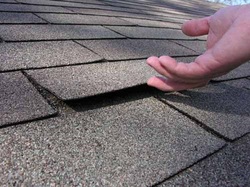
While it is widely known, that pressure washing is an effective way to clean surfaces from lichen, (a fungus, that has no roots and grows symbiotically with algae to form a crust-like growths) algae, mold and mildew as well as general dirt, it sometimes raises the question, if pressure washing is actually safe and not damaging the surface.
To understand this, you have to know, what you are dealing with: Your asphalt shingle roof provides an excellent food source for these organisms giving them everything they need to grow. Asphalt shingles today contain limestone fillers to help add weight to the shingles. The algae feeds on these limestone fillers, and over time this feeding process by the algae will actually degrade your roofs shingles. This can result in decreasing the life span of your roof by years.
To remove algae and lichen, the water pressure has to be stronger than what’s coming out of your ordinary garden hose. Without using a power washer with a strong jet of water, the dirt or lichen wouldn’t come off. However, the pressure used can be adjusted from low to high to make it safe for most surfaces. A professional technician operating a pressure washer would always inspect the surfaces first and then decide and pick the correct setting.
If your roof shingles are already damaged or loose, you probably don’t want to have it pressure cleaned. At that point a repair or even a new roof could be in place. But generally speaking, pressure washing an asphalt shingle roof is safe when done by an expert. I have included a short video, presented by a professional, that nicely shows, how to safely use a pressure washer to clean your asphalt shingle roof.
However, if you don’t aspire to clean your own roof and realize how much (dirty) work it really is, just give me a call. I have the knowledge, the experience and the equipment to get your roof back into shape, looking as good as new!
Need a FREE Quote?
Call 1-813-991-7243
To understand this, you have to know, what you are dealing with: Your asphalt shingle roof provides an excellent food source for these organisms giving them everything they need to grow. Asphalt shingles today contain limestone fillers to help add weight to the shingles. The algae feeds on these limestone fillers, and over time this feeding process by the algae will actually degrade your roofs shingles. This can result in decreasing the life span of your roof by years.
To remove algae and lichen, the water pressure has to be stronger than what’s coming out of your ordinary garden hose. Without using a power washer with a strong jet of water, the dirt or lichen wouldn’t come off. However, the pressure used can be adjusted from low to high to make it safe for most surfaces. A professional technician operating a pressure washer would always inspect the surfaces first and then decide and pick the correct setting.
If your roof shingles are already damaged or loose, you probably don’t want to have it pressure cleaned. At that point a repair or even a new roof could be in place. But generally speaking, pressure washing an asphalt shingle roof is safe when done by an expert. I have included a short video, presented by a professional, that nicely shows, how to safely use a pressure washer to clean your asphalt shingle roof.
However, if you don’t aspire to clean your own roof and realize how much (dirty) work it really is, just give me a call. I have the knowledge, the experience and the equipment to get your roof back into shape, looking as good as new!
Need a FREE Quote?
Call 1-813-991-7243
Understanding what you are dealing with: "The Attacker"
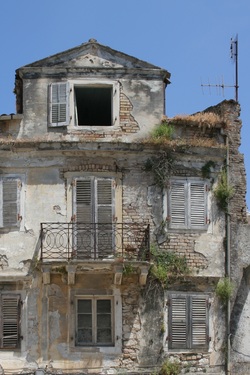
Here we explain the causes of algae, moss, lichens, or fungal growth on roof shingles, the effects of these conditions, and how to cure or prevent them. Just brushing or raking off moss won't prevent future moss growth, and if roof cleaning is not done with care you risk damaging the shingles and reducing the life of the roof.
Causes of moss or lichens growth on roofs
Moss growing on any roof surface will be more severe on roof sections that are shaded. The presence or absence of much sunlight on a roof surface is often the determining factor in the amount of moss or lichens growth (more sun = less moss and lichens). When shade and moist conditions combine, moss and lichens growth on a roof is more likely.
Moss and lichens are more than a cosmetic issue on many kinds of roofing materials - asphalt shingles, roll roofing, wood shingle roofs, wood shake roofs. By holding moisture against the roof surface longer, lichens - but more so moss - speed the wear of the asphalt shingle surface by damaging the mineral granule coating on the shingles and thus reduce the life of the roof covering.
Particularly where the roofing materials are asphalt shingles or wood shingles, holding water on the roof surface by any means (leaves, debris, moss, or lichens) speeds up wear on these shingles. In non-freezing climates, the roots or growth structures of moss or lichens eventually penetrate and separate the roof shingle materials, speeding their demise.
Because lichens growing on a roof surface does not have as much thickness of body as moss, it will hold less water on the roof surface and is less of a wear factor than moss. Therefore if we have only lichens growing on a roof surface we would be less quick to try to clean it off since lichens not only has a tighter "grip" on the roof surface but the cleaning process for lichens risks doing more harm than good to the roof surface. (See also "Roof maintenance and care" last paragraph for a solution.)
If you want to know more specifics about different kinds of fungus, algae etc. here is a great website to consult: Guide to Identifying, Removing, Preventing Algae, Fungus, Lichens, Moss on Roof Shingles.
Need a FREE Quote?
Call 1-813-991-7243
Causes of moss or lichens growth on roofs
Moss growing on any roof surface will be more severe on roof sections that are shaded. The presence or absence of much sunlight on a roof surface is often the determining factor in the amount of moss or lichens growth (more sun = less moss and lichens). When shade and moist conditions combine, moss and lichens growth on a roof is more likely.
Moss and lichens are more than a cosmetic issue on many kinds of roofing materials - asphalt shingles, roll roofing, wood shingle roofs, wood shake roofs. By holding moisture against the roof surface longer, lichens - but more so moss - speed the wear of the asphalt shingle surface by damaging the mineral granule coating on the shingles and thus reduce the life of the roof covering.
Particularly where the roofing materials are asphalt shingles or wood shingles, holding water on the roof surface by any means (leaves, debris, moss, or lichens) speeds up wear on these shingles. In non-freezing climates, the roots or growth structures of moss or lichens eventually penetrate and separate the roof shingle materials, speeding their demise.
Because lichens growing on a roof surface does not have as much thickness of body as moss, it will hold less water on the roof surface and is less of a wear factor than moss. Therefore if we have only lichens growing on a roof surface we would be less quick to try to clean it off since lichens not only has a tighter "grip" on the roof surface but the cleaning process for lichens risks doing more harm than good to the roof surface. (See also "Roof maintenance and care" last paragraph for a solution.)
If you want to know more specifics about different kinds of fungus, algae etc. here is a great website to consult: Guide to Identifying, Removing, Preventing Algae, Fungus, Lichens, Moss on Roof Shingles.
Need a FREE Quote?
Call 1-813-991-7243
Using A Pressure Washer To Clean A Deck
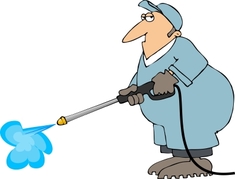
Whether you deck is wood or composite, periodic cleaning is a requirement if you want your deck to retain the beauty it had on day one. Periodic cleaning is your preventative maintenance. This maintenance, done correctly, will do more than add years to your deck; it can save you time and money in the long run.
Let me show you a common scenario, when you embark on this task yourself for the first time:
You have rented a pressure washer from the local rental store. The sales clerk has assured you that this machine will clean your deck “No problem.” You get home and from what you heard, you feel, that washing your deck is rather easy. Your next step is setting up the machine: You hook up the water supply lines and attach the high pressure hose and the gun. After turning on the water you start the machine and it roars to life.
You approach your deck and point the tip of your gun at the deck. You squeeze the trigger and a jet of water comes forth. Next thing you know, you’re cleaning your deck! Well, maybe or maybe not, because after you release the trigger and inspect your work you realize, that besides removing the dirt (Hooray!!), you also removed ¼” of wood leaving behind a board that has now an uneven surface and doesn’t look like the nice flat board you had only moments ago. (Oh nooo!!!) The happy deck cleaner you were has mutated into a DYI’er with a bruised ego. The words "No Problem!" echo in your mind...
I don’t want to discourage you on taking on this task yourself, but I’d like you to know what you get yourself into once you have started the cycle. So forgive me, if my description doesn’t sound too inviting: It is a task that is best done by a professional with enough experience to avoid all the time-consuming mistakes. Besides - let’s face it - it really is a dirty job ;-)
For all those passionate DYI’ers who like to put on their rubber boots and really want to learn in detail how to clean their own deck, please read this comprehensive article from decks.com.
Everyone else: Give me a call and help is on your way! Tampa / Clearwater office 24/7: 1-813-991-7243
PressureWashingClearwater.com
Serving the Tampa Bay area since 1996
Let me show you a common scenario, when you embark on this task yourself for the first time:
You have rented a pressure washer from the local rental store. The sales clerk has assured you that this machine will clean your deck “No problem.” You get home and from what you heard, you feel, that washing your deck is rather easy. Your next step is setting up the machine: You hook up the water supply lines and attach the high pressure hose and the gun. After turning on the water you start the machine and it roars to life.
You approach your deck and point the tip of your gun at the deck. You squeeze the trigger and a jet of water comes forth. Next thing you know, you’re cleaning your deck! Well, maybe or maybe not, because after you release the trigger and inspect your work you realize, that besides removing the dirt (Hooray!!), you also removed ¼” of wood leaving behind a board that has now an uneven surface and doesn’t look like the nice flat board you had only moments ago. (Oh nooo!!!) The happy deck cleaner you were has mutated into a DYI’er with a bruised ego. The words "No Problem!" echo in your mind...
I don’t want to discourage you on taking on this task yourself, but I’d like you to know what you get yourself into once you have started the cycle. So forgive me, if my description doesn’t sound too inviting: It is a task that is best done by a professional with enough experience to avoid all the time-consuming mistakes. Besides - let’s face it - it really is a dirty job ;-)
For all those passionate DYI’ers who like to put on their rubber boots and really want to learn in detail how to clean their own deck, please read this comprehensive article from decks.com.
Everyone else: Give me a call and help is on your way! Tampa / Clearwater office 24/7: 1-813-991-7243
PressureWashingClearwater.com
Serving the Tampa Bay area since 1996
Care Tip Pressure Washing: Decks, Patios and other outside sitting areas

Green stains due to algae: If you see flat green stains on a building exterior that is not producing plant-like raised growth, it is likely to be an algae. Green stains can appear on buildings including on shingles, siding, and even on masonry walls, sidewalks, decks, planters and retaining walls: stone, concrete block, and concrete.
Watch out: On walks and decks algae makes for a dangerously slippery surface when it is wet. Gentle pressure washing will remove the algae and leave your deck or walk looking like new.
Deck cleaning: Cleaning the deck by yourself isn't an easy task especially when you're busy with other things that you can't have enough time for deck maintenance. You can hire power washing company to do the job for you instead. Dirt, grime, mud, pet hair etc can attach itself to your deck or patio surface. Keeping your deck clean is very important in reducing other problems like mold and mildew. Simply blowing off the deck or sweeping it once in a while will greatly reduce dirt and grime to get stuck and also helps to keep the decking gaps open for drainage. If you are in the mood or have people over to help, you can clean your really dirty deck as you would clean a car: A big bucket with soapy water (detergent), a brush and a hose will do wonders on any kind of deck be it treated wood or composite or cellular PVC.
Clean decks drain better, are less likely to promote mold growth, and less likely damaged from scratching.
Pressure Washing: OK, not everyone wants to get down and dirty and scrub their deck by hand. Pressure washers make quick work of it and can't be denied as time savers. If your are not an expert in using a pressure washer, you can do damage if not carefully handled. There are pressure washers available delivering upwards of 3000 PSI and that much concentrated force can easily dig in or damage softer deck materials. When using some chemicals first, you should only need a 1500-1600 PSI washer.This will greatly reduce the chance of damaging your deck, but even still it is important to keep the spray fan moving and overlap or feather your strokes carefully, trying not get too close or stay in one spot too long. Remember also to give your cleaning solution a chance to work before you start pressure washing. Finally allow drying time when the sun is still high, to maximize cleaning benefits.
Need a FREE Quote?
Call 24/7 1-813-991-7243
Watch out: On walks and decks algae makes for a dangerously slippery surface when it is wet. Gentle pressure washing will remove the algae and leave your deck or walk looking like new.
Deck cleaning: Cleaning the deck by yourself isn't an easy task especially when you're busy with other things that you can't have enough time for deck maintenance. You can hire power washing company to do the job for you instead. Dirt, grime, mud, pet hair etc can attach itself to your deck or patio surface. Keeping your deck clean is very important in reducing other problems like mold and mildew. Simply blowing off the deck or sweeping it once in a while will greatly reduce dirt and grime to get stuck and also helps to keep the decking gaps open for drainage. If you are in the mood or have people over to help, you can clean your really dirty deck as you would clean a car: A big bucket with soapy water (detergent), a brush and a hose will do wonders on any kind of deck be it treated wood or composite or cellular PVC.
Clean decks drain better, are less likely to promote mold growth, and less likely damaged from scratching.
Pressure Washing: OK, not everyone wants to get down and dirty and scrub their deck by hand. Pressure washers make quick work of it and can't be denied as time savers. If your are not an expert in using a pressure washer, you can do damage if not carefully handled. There are pressure washers available delivering upwards of 3000 PSI and that much concentrated force can easily dig in or damage softer deck materials. When using some chemicals first, you should only need a 1500-1600 PSI washer.This will greatly reduce the chance of damaging your deck, but even still it is important to keep the spray fan moving and overlap or feather your strokes carefully, trying not get too close or stay in one spot too long. Remember also to give your cleaning solution a chance to work before you start pressure washing. Finally allow drying time when the sun is still high, to maximize cleaning benefits.
Need a FREE Quote?
Call 24/7 1-813-991-7243
Care Tip Pressure Washing: Roof maintenance and care

- Give the roof surface more sunlight: This may sound funny, since we live in the Sunshine State and try to avoid the direct sunlight to reduce energy costs. However, I want to mention this point for those houses that are "too shaded" by trees. Either trim back trees whose branches overshadow the roof surface or keep the roof clean of organic debris like leaves or pine needles, which may collect in valleys or at other roof locations.
- Remove or trim large or tall sick trees: You don't want a big tree in poor health to fall or be blown onto the building, say in a storm, so it's important to cut off dead branches entirely and to have a tree expert assess the health of large trees near a building. Watch out: Some "tree experts" just love to cut everything down. Consult experienced tree service companies who know not only trimming procedures but how to assess tree health. Also trees growing within five feet of a building are more likely to send out roots that can damage the structure - with the risk varying by tree species.
- Remove dead branches: You don't want tree branches falling onto a roof where they may cause damage and leaks - see (2) above.
- Prevent on-roof debris accumulation: Tree leaves and debris accumulating on a roof should be avoided, because of both cosmetic staining and long term wear and leaks below the debris.
- Reduce roof gutter clogging: It sometimes makes sense to also trim brack branches whose pine needles or leaves are falling into and rapidly clogging gutters. So the amount of trimming and safe distance depend on the home, roof slope, roof drainage details, and the height and health and distance of trees near the building.
- Reduce moss, algae, and perhaps fungal growth on some roof surfaces by reducing the opportunities for fungus, moss and algae to grow (see also above: "The Attacker"). There is also an excellent website I can recommend which identifies all the different types of stains and "aggressors" in our environment and how to deal with them as a house owner: Guide to Identifying, Removing, Preventing Algae, Fungus, Lichens, Moss on Roof Shingles.
If you want to take it a step further you can also prepare your roof by installing copper and other metal strips along the ridge of an existing roof which will slowly kill off moss or lichens as rainwater washes over the metal and down the roof surface. This method is suitable for both prevention of future or further moss or lichens growth on the roof and for gently treating an otherwise fragile old roof. (Also see this video on how to do this by one of the leading DIY magazines "This Old House": How to Remove Roof Moss).
Need a FREE Quote?
Call 24/7 1-813-991-7243
As a recommendation:

Getting the help of an experienced pressure cleaning company will save you the time and headache of possibly damaging your roof or deck by doing it yourself.
Try our professional pressure washing services and get your FREE Pressure Washing Quote today, or call now our Tampa /Clearwater office 24/7: 1-813-991-7243
Try our professional pressure washing services and get your FREE Pressure Washing Quote today, or call now our Tampa /Clearwater office 24/7: 1-813-991-7243
- We are FULLY LICENSED AND INSURED!
- We keep our promises!
- We are on time or keep you updated, if we are running late!
- We guarantee 100% customer satisfaction!

